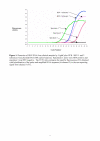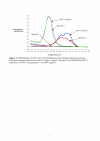Detection and subtyping of Herpes simplex virus in clinical samples by LightCycler PCR, enzyme immunoassay and cell culture
- PMID: 12069697
- PMCID: PMC116582
- DOI: 10.1186/1471-2180-2-12
Detection and subtyping of Herpes simplex virus in clinical samples by LightCycler PCR, enzyme immunoassay and cell culture
Abstract
Background: Prompt laboratory diagnosis of Herpes simplex virus (HSV) infection facilitates patient management and possible initiation of antiviral therapy. In our laboratory, which receives various specimen types for detection of HSV, we use enzyme immunoassay (EIA) for rapid detection and culture of this virus. The culture of HSV has traditionally been accepted as the diagnostic 'gold standard'. In this study, we compared the use of real time PCR (LightCycler) for amplification, detection and subtyping of specific DNA with our in-house developed rapid and culture tests for HSV.
Results: The LightCycler PCR (LC-PCR) detected and subtyped HSV in 99% (66/67) of HSV positive specimens, compared to 81% (54/67) by rapid antigen EIA or 57% (36/63) by culture. A specimen was considered positive when two or more tests yielded HSV identifications or was culture positive. Discordant results were confirmed with an in-house developed PCR-ELISA or DNA sequence analysis. The typing results obtained with the LC-PCR and by culture amplified test were completely concordant.
Conclusions: This study showed that the LC-PCR provided a highly sensitive test for simultaneous detection and subtyping of HSV in a single reaction tube. In addition to increased sensitivity, the LightCycler PCR provided reduced turn-around-times (2 hours) when compared to enzyme immunoassay (4 hours) or culture (4 days).
Figures
Similar articles
-
Comparison of Light-Cycler PCR, enzyme immunoassay, and tissue culture for detection of herpes simplex virus.Diagn Microbiol Infect Dis. 2001 Jul;40(3):107-10. doi: 10.1016/s0732-8893(01)00260-7. Diagn Microbiol Infect Dis. 2001. PMID: 11502377
-
A comparison of PCR with virus isolation and direct antigen detection for diagnosis and typing of genital herpes.J Med Virol. 1998 Jun;55(2):177-83. J Med Virol. 1998. PMID: 9598940
-
Detection and differentiation of herpes simplex virus types 1 and 2 by a duplex LightCycler PCR that incorporates an internal control PCR reaction.J Clin Virol. 2004 May;30(1):32-8. doi: 10.1016/j.jcv.2003.08.003. J Clin Virol. 2004. PMID: 15072751
-
Rapid detection, culture-amplification and typing of herpes simplex viruses by enzyme immunoassay in clinical samples.Clin Diagn Virol. 1998 May 1;10(1):67-74. doi: 10.1016/s0928-0197(98)00003-8. Clin Diagn Virol. 1998. PMID: 9646003
-
Tests for detecting herpes simplex virus and varicella-zoster virus infections.Dermatol Clin. 1994 Jan;12(1):51-68. Dermatol Clin. 1994. PMID: 8143385 Review.
Cited by
-
Highly sensitive and naked-eye detection of herpes simplex virus type 1 using LAMP- CRISPR/Cas12 diagnostic technology and gold nanoparticles.Heliyon. 2023 Nov 10;9(11):e22146. doi: 10.1016/j.heliyon.2023.e22146. eCollection 2023 Nov. Heliyon. 2023. PMID: 38034811 Free PMC article.
-
Comparison of specimen processing and nucleic acid extraction by the swab extraction tube system versus the MagNA Pure LC system for laboratory diagnosis of herpes simplex virus infections by LightCycler PCR.J Clin Microbiol. 2005 Mar;43(3):1059-63. doi: 10.1128/JCM.43.3.1059-1063.2005. J Clin Microbiol. 2005. PMID: 15750060 Free PMC article.
-
Effect of sequence polymorphisms on performance of two real-time PCR assays for detection of herpes simplex virus.J Clin Microbiol. 2005 May;43(5):2391-8. doi: 10.1128/JCM.43.5.2391-2398.2005. J Clin Microbiol. 2005. PMID: 15872272 Free PMC article.
-
Diagnostics for herpes simplex virus: is PCR the new gold standard?Mol Diagn Ther. 2006;10(1):17-28. doi: 10.1007/BF03256439. Mol Diagn Ther. 2006. PMID: 16646574 Review.
-
HSV-2- and HIV-1- permissive cell lines co-infected by HSV-2 and HIV-1 co-replicate HSV-2 and HIV-1 without production of HSV-2/HIV-1 pseudotype particles.Virol J. 2007 Jan 5;4:2. doi: 10.1186/1743-422X-4-2. Virol J. 2007. PMID: 17207276 Free PMC article.
References
-
- Cone RW, Hobson AC, Palmer J, Remington M, Corey L. Extended duration of herpes simplex virus DNA in genital lesions detected by the polymerase chain reaction. J Infect Dis. 1991;164:757–60. - PubMed
-
- Grizzle JE, et al. Analysis of categorical data by linear models. Biometrics. 1969;25:489–503. - PubMed
MeSH terms
Substances
LinkOut - more resources
Full Text Sources
Other Literature Sources



